The monuments and statues in Edinburgh are as much part of the city’s history as the ancient fortress that looks down from the Castle Rock.
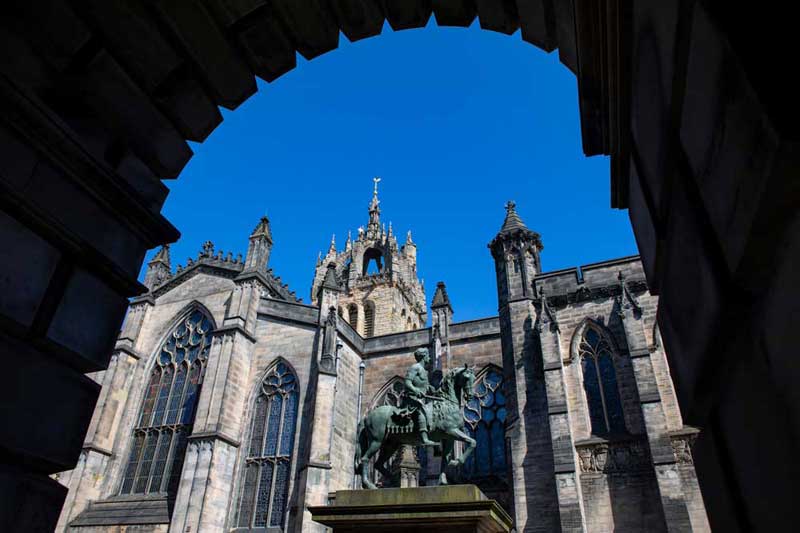
Edinburgh has a long tradition of erecting monuments and statues, reminders of historic events and famous citizens.
But in the rush to visit the city’s best-known tourist attractions, it’s easy to walk past some of the less obvious statues without pausing to wonder who they were and what their contribution to the city was.
The history of Edinburgh
” Edinburgh monuments tell us about the history of the city – like a museum collection, but on display in the parks and streets.”
Museums & Galleries Edinburgh
Edinburgh World Heritage
Edinburgh World Heritage said, “Edinburgh’s statues and monuments are among the city’s most distinctive and precious assets, often taking centre-stage and greatly contributing to the rich and complex character of the Old and New Town World Heritage Site.”
For easier reading, this list of Edinburgh monuments is divided into sections: the Old Town, the New Town and Princes Street Gardens, the traditional dividing line between Old and New.
Where possible, there are links to further information from authoritative sources including feature articles on Truly Edinburgh.
Edinburgh monuments and statues: Old Town
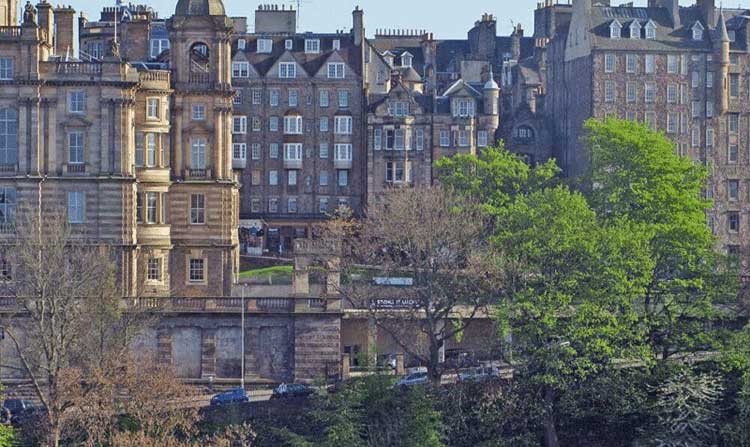
King Charles II (1630- 1685)
The statue of King Charles II on horseback in Parliament Square near St Giles’s Cathedral is the oldest statue in Edinburgh. (see image at top of page).
First erected in 1685, it shows the king dressed in Roman military attire. Although it was probably imported from Holland, Robert Mylne, the King’s master Mason in Scotland carved the original plinth.
The statue has been restored a number of times over the years. Historic Environment Scotland has more information.
David Hume (1711-1776) philosopher and historian
The statue of David Hume, regarded by many to be the greatest philosopher to write in the English language sits on the Lawnmarket, part of the Royal Mile, opposite St Giles Cathedral.
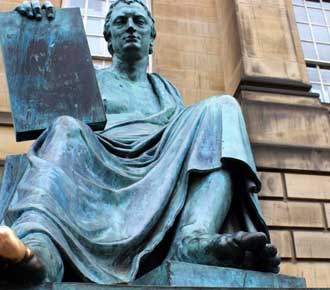
More information about Hume on this Truly Edinburgh feature article.
The Bow Well
The Bow Well (Bowfoot Well), built in 1674 (since renovated) was the first well head to supply water from the Castle Hill reservoir to Edinburgh’s Grassmarket.
Mary Queen of Scots (1542-1587
Outside Edinburgh City Chambers, on the Royal Mile, a plaque marks the place where Mary spent her last night in Edinburgh before being imprisoned in Lochleven Castle.
The inscription reads:
“On this site stood the lodging of sir Simon Preston of Craigmillar, Provost of the city 1566-7 in which Mary Queen of Scotland after her surrender to the Confederate Lords at Carberry Hill spent her last night in Edinburgh, 15th June 1567……”
Anon
James Braidwood (1800-1861) Superintendent of Fire Engines
Also in Parliament Square, and sadly often overlooked, is the statue of the remarkable James Braidwood who founded the world’s first municipal fire service in Edinburgh.
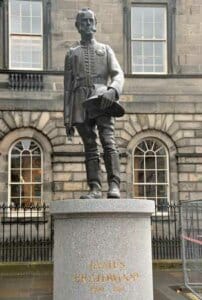
As the Superintendent of Fire Engines, he helped fight the Great Fire of Edinburgh which raged through the Old Town in 1824.
Greyfriars Bobby
Greyfriars Bobby was the little dog whose much-loved statue stands close to Greyfriars kirkyard and the memorial of his owner John Gray.
It was Lord Provost William Chambers who arranged for Edinburgh council to pay the dog licence to save Bobby from being treated as a stray
Bobby, a Skye Terrier, had reportedly guarded his master’s grave for over a decade.
William Chambers (1800-1883) publisher, politician and social reformer.
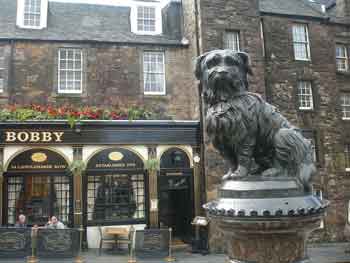
While William Chambers is best remembered for helping the little dog Greyfriars Bobby.
As Lord Provost of Edinburgh between 1865 and 1869, he saw the passing of the City Improvement Act, instrumental in sweeping away much of the slum housing in Edinburgh’s Old Town.
William was also a writer and working with his brother Robert founded the publisher W and R Chambers, today part of a larger publishing business.
Robert Fergusson (1750-1774) poet
When you see the statue of Robert Fergusson, positioned outside Canongate Church on Edinburgh’s Royal Mile. you might well think that he was a man in a hurry.
Sometimes considered the forerunner of Robert Burns, Fergusson was a poet of remarkable depth. Born in Edinburgh’s Old Town he studied at the University of St Andrews.
The BBC described him as a “poet with an exquisite range and a corpus of around 100 poems.”
His best-known work was probably the wonderfully evocative Auld Reikie, A poem (1773) which told the story of Edinburgh, in all its finery but was not afraid to mention its depravity.
To describe Fergusson’s life as eventful would certainly be an understatement. Because his entry here is much too brief, I’ve put a link to a really good BBC article about his life and work.
Robert the Bruce (left) and William Wallace statues
William Wallace and Robert the Bruce, two of Scotland’s greatest heroes stand guard at the entrance of Edinburgh Castle welcoming thousands of visitors as they file through the gate.
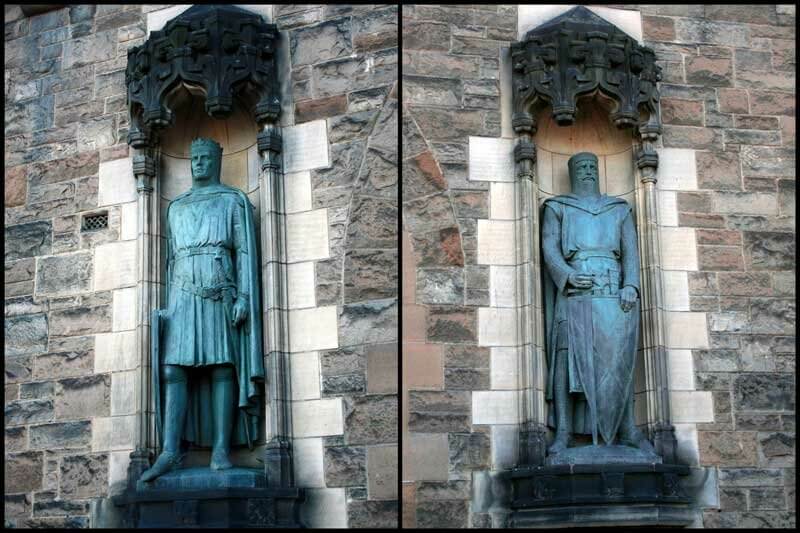
The Mercat Cross of Edinburgh
Edinburgh’s Mercat or market Cross, which stands close to St Giles Cathedral on the Royal Mile, was where merchants congregated and ‘did business’. It was also the site of executions, other public gatherings and formal proclamations.
A paper (1986) from the Society of Antiquaries of Scotland, The Mercat Cross of Edinburgh, from 1365 to 1617 – its Site and Form, written by Peter Miller paints a fascinating picture of this historic Edinburgh landmark.
Adam Smith (1723-1790) political economist and philosopher
The distinctive bronze Adam Smith statue was placed close to St Giles’ Cathedral in 2008.
This makes Adam Smith, complete with a University of Glasgow gown, a relatively new figure on the Royal Mile.
It seems the project to commemorate the author of the Inquiry into the Nature and Causes of the Wealth of Nations, in this way, had the full support of Baroness Thatcher and others.
Although Smith had close connections with Glasgow, he died in Edinburgh and was buried in Canongate Kirkyard.
This article from the Adam Smith Institute says more about the statue.
William Henry Playfair (1790- 1857) architect
Surveying the scene outside the National Museum of Scotland the statue of William Playfair stands close to that of William Chambers.
This new statue of Playfair was lowered into place in 2016 and is a reminder of the life of one of Scotland’s most distinguished architects.
Among Playfair’s best-known design projects were the Playfair Library at the University of Edinburgh’s Old College, the National Gallery of Scotland and some of the later extensions to Edinburgh’s New Town.
Edinburgh monuments and statues: Princes Street Gardens
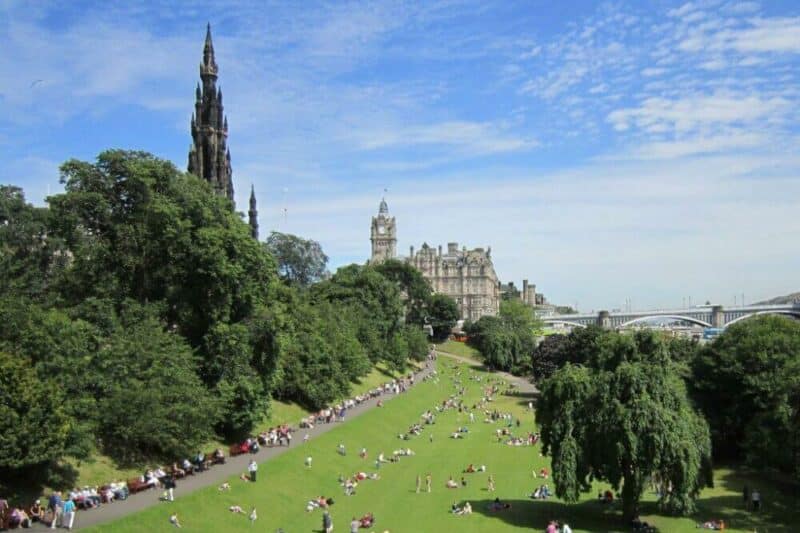
Princes Street Gardens are generally considered to be the dividing line (the old Nor Loch), drained in the 18th century) between Edinburgh’s Old and New Towns, so all the monuments listed in this section lie within the Gardens which are split into east and west sections.
Sir Walter Scott (1771-1832) lawyer and writer
While perhaps not quite as tall as the Melville Monument, the Scott Monument in Princes Street Gardens is Edinburgh’s most distinctive landmark. You can actually climb, 287 stairs to the top of it. While you might be puffing a bit at the top but the view is a great reward.
David Livingstone (1813- 1873) explorer and missionary
The David Livingstone statue, complete with lion skin behind him, was unveiled in 1876, in Princes Street Gardens.
It commemorated a man regarded as a Victorian hero, although later scholars might argue that his halo had slipped.
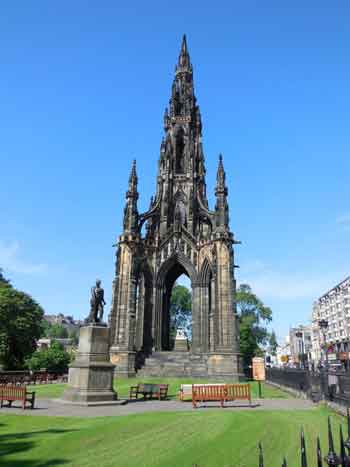
Allan Ramsay (1684-1758) poet and publisher
The Allan Ramsay Monument was erected in memory of a man who flourished in the early period of the Scottish Enlightenment. Ramsay, who was buried in Greyfriars Kirkyard, was the father of Allan Ramsay the artist.
Sir John Steele designed the statue while David Bryce carved the sandstone plinth.
John Wilson (1785 – 1854) writer and academic
Unveiled in East Princes Street Gardens in 1865, the John Wilson memorial remembers a man who wrote for Blackwood’s Magazine using the pseudonym, Christopher North. He also held the position of Professor of Moral Philosophy at the University of Edinburgh.
Norwegian Stone
Unveiled in 1978 the Norwegian commemorative monument is a large boulder placed on top of a number of smaller stones.
It’s an evocative reminder of the Norwegian army played in WW2 and the help their soldiers received from the people of Scotland where they trained.
The memorial which sits in West Princes Street Gardens has two inscriptions. On the front it says:
“During the war years 1940-45/ the Norwegian Brigade and other army units were raised and trained in Scotland/ here we found hospitality, friendship and hope during the dark days of exile…”
Anon
Royal Scots Grey
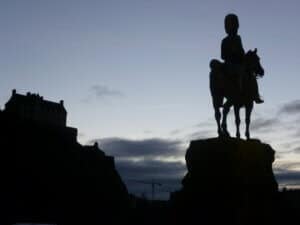
The mounted figure of a Royal Scots Grey trooper is among the best-known of Edinburgh’s monuments. It sits in West Princes Street Gardens.
Interestingly the soldier is dressed as he would have been when the regiment went to South Africa in 1899.
A number of inscriptions remember the soldiers who died in the Boer War and World War One.
Bum the dog
Immortalised in bronze, Bum the dog lies quietly in West Princes Street Gardens.
The story of Bum began in San Diego, California. It seems that this lovable vagabond, a St Bernard-spaniel mix, captured the hearts of many Americans.
The US city was twinned with Edinburgh in 1978. Consequently, in recognition of the relationship between the cities, a statue of Greyfriars Bobby has now taken up residence in San Diego’s Gaslamp Quarter.
Each city is home to a famous dog:
“Edinburgh’s loyal and beloved Greyfriars Bobby and San Diego’s equally beloved vagabond dog, Bum. In recognition of these canine heroes, a statue of Bobby was presented to San Diego and this statue of Bum was gifted in return.”
Public Monuments and Sculpture Association: Edinburgh
This short article from Historic Environment Scotland (Canmore) says a little about the statue.
Edinburgh monuments and statues: New Town
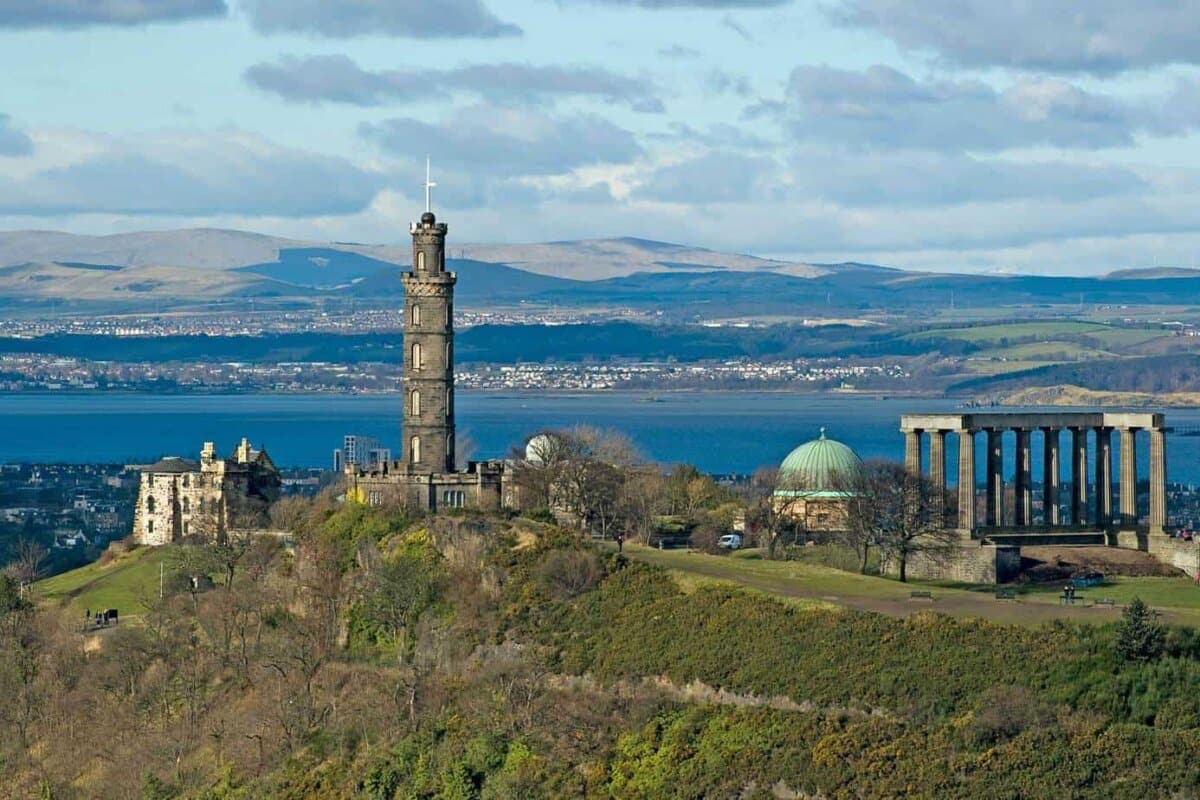
Duke of Wellington on horseback
The statue of the Duke of Wellington on horseback sits outside Register House on Princes Street, across the road from the Balmoral Hotel.
Famously, the Duke is often seen wearing a traffic cone on his head, the result of some over-exuberance from the good folk of Edinburgh.
Henry Dundas, 1st Viscount Melville (1742- 1811) politician and lawyer
The towering 150 feet high Melville Monument, inspired by Trajan’s Column in Rome sits in St Andrews Square which lies at the heart of Edinburgh New Town.
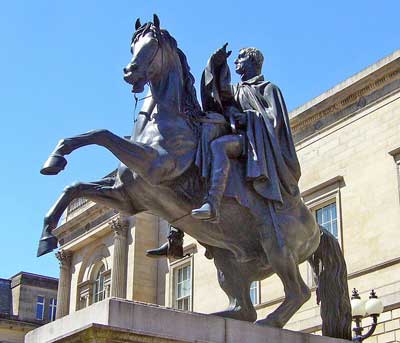
This statue is a reminder of a powerful man whose role in the transatlantic slave trade remains controversial and hotly debated.
He was impeached in 1806 for the misuse of naval funds and although acquitted at his trial he was subsequently forced out of politics.
The National Records of Scotland say more about Dundas.
Scottish-American Soldiers monument
This monument which depicts the figure of Abraham Lincoln stands in Old Calton Burial Ground and was unveiled in 1893 in memory of the Scots killed in the American Civil War.
Dugald Stewart (1753-1828) philosopher and mathematician
Also on Calton Hill is the Dugald Stewart Monument
Stewart was a distinguished philosopher and mathematician. His father was a professor of mathematics at the University of Edinburgh. He was one of the great figures of the Scottish Enlightenment.
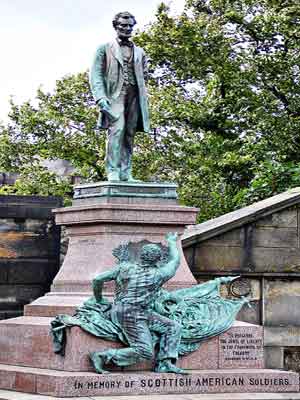
Find out more about Dugald Stewart in this Truly Edinburgh feature article.
The National Monument
The National Monument on Calton Hill was built to commemorate the Scots who died in the Napoleonic Wars.
Intended to be a copy of the Parthenon on the Athenian Acropolis the foundation stone was laid in 1822 during the royal visit of George IV to Edinburgh. Building began in 1826, but as money ran out the project was never finished.
In some eyes, the Monument became “Edinburgh’s disgrace”
Nelson Monument
The Nelson Monument at the top of Calton Hill was built between 1807 and 1815. This remarkable edifice, in the shape of an upturned telescope, was built in memory of Admiral Lord Nelson who died at the battle of Trafalgar in 1805.
Burns Monument
Sited on Regents Road at the foot of Calton Hill, this monument, a Corinthian temple say Historic Environment Scotland designed by architect Thomas Hamilton and built in the Greek Revival style.
The foundation stone was laid in 1831.
The original statue of Burns which stood inside the monument is now in the Scottish National Portrait Gallery.
The simple inscription on the plinth says “Robert Burns, Born near Ayr, 25th January 1759 Died at Dumfries, 21st July 1796”
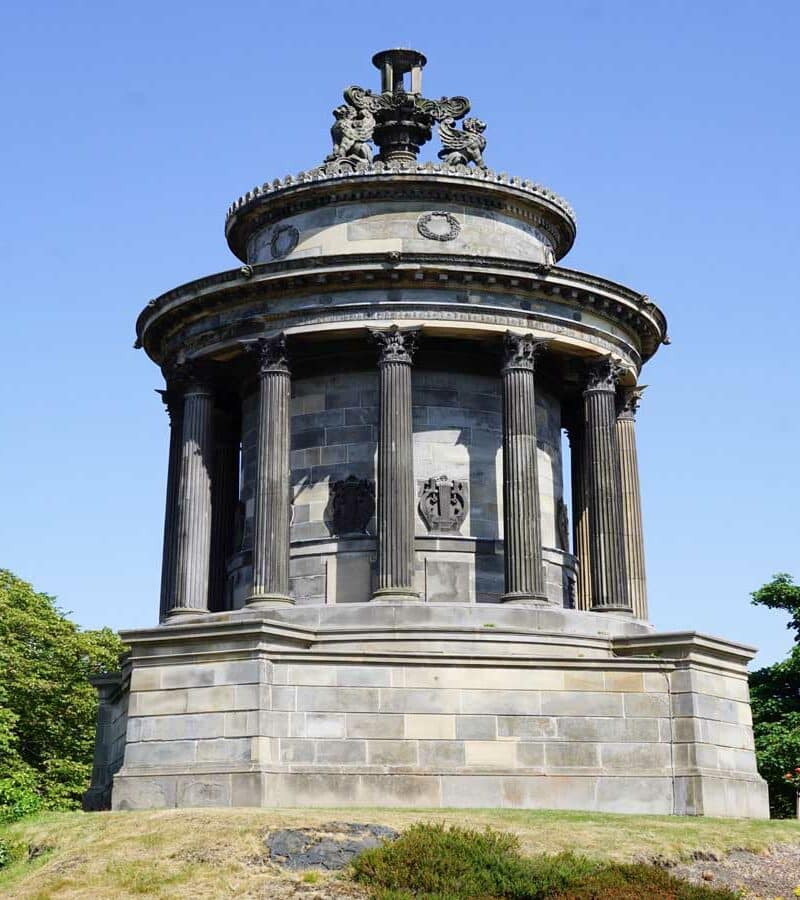
Catherine Sinclair (1800-1864) novelist and philanthropist
Catherine Sinclair was born in number 6 Charlotte Square, a New Town property that is now the official residence of the first Minister of Scotland
The Catherine Sinclair monument stands not far from the place of her birth. A monument to a woman is a rare thing in Scotland’s capital city.
The statue commemorates her life as an author and a compassionate woman who cared for her fellow citizens of Edinburgh. Her legacy, should you know where to look, remains to be discovered.